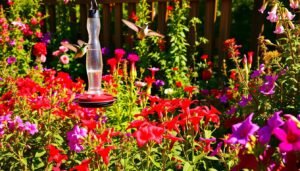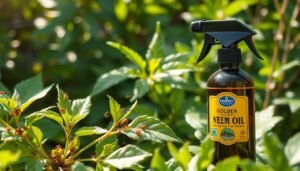As I step into my garden, the crisp air fills me with hope. I see my Brussels sprouts and feel worried—the holes in their leaves are clear. It’s upsetting to see pests ruining my hard work.
I love growing these greens, but pests have hurt my dreams of a big harvest. I want to know who’s causing this damage. Finding out is key to saving my garden. After carefully reading this article hope you will get the answer of what Is making holes in my Brussel Sprout Leaves? .
Key Takeaways
- Identify brussels sprout pests to take timely action.
- Aphids can quickly reproduce and damage plant health.
- Common pests like cabbage loopers can skeletonize leaves.
- Cultivars of Brussels sprouts vary in pest resistance.
- Understanding pest behaviors aids in effective management.
Table of Contents
Understanding the Issue: What Is Making Holes in My Brussel Sprout Leaves?
It’s important to know about leaf damage in Brussels sprouts to keep them healthy. Holes in leaves are common, especially in cole crops. These issues might look minor at first, but pests can harm both the quality and yield of sprouts.
Spotting problems early is key to managing leaf damage well. Aphids often attack the top of leaves, while cabbage worms make big holes on the underside. Watch closely, as pests can damage plants fast, especially in heavy clay soil.
Environmental factors also cause leaf damage. Heavy winds or rain can tear leaves. Nutrient shortages, like a lack of calcium, can also lead to holes in leaves. To fight these problems, use good pest control and keep growing conditions right.
If you want to learn more about pest management, check out thisresource. It offers tips on dealing with pests that cause holes in Brussels sprout leaves. It also gives advice on how to protect your plants.
The Common Culprits Behind Leaf Damage
Leaf damage in Brussels sprouts comes from many pests. Knowing these pests helps us fight them. Some insects are especially bad at causing harm.
- European Earwigs: These pests chew holes in leaves, especially in young plants.
- Squash Bugs: They grow big and damage many crops.
- Leaf Miners: They make tan blotches on leaves, harming spinach and Swiss chard.
- Cabbage Root Maggot Fly: Their eggs harm plants, causing them to wilt.
- Cucumber Beetles: They can make seedlings wilt and spread disease in Massachusetts.
Deer also damage plants, making it hard to tell if it’s them or rabbits.
In Virginia, three moths harm cabbage family crops. These moths have a long life cycle. They leave pupae that stay in the soil all winter.
Knowing which insects harm Brussels sprouts helps protect them. By understanding these pests, we can act fast to save our garden.
What is Making Holes in My Brussels Sprout Leaves?
Figuring out what’s making holes in my Brussels sprout leaves often points to pests. Aphids, cabbage loopers, and armyworms are common culprits. They damage the leaves and harm the plants’ health and yield.
Aphids love to infest brassicas, like Brussels sprouts. They hide in leaf crevices. To fight them, I trim damaged areas, remove outer leaves, and wash with water. Sometimes, I must throw away heavily infested sprouts.
Cabbage loopers leave holes and shredded leaves. Spotting them early helps me control them. I use safe solutions or pick them off. Armyworms also damage leaves and reduce my yield.
Knowing the threats to my Brussels sprouts is key to keeping them healthy. For more tips on fighting pests and a thriving garden, check this resource.
Identifying Brussels Sprout Pests
It’s key to spot pests early to keep Brussels sprouts healthy. Knowing what pests look like helps a lot. I’ve found that looking at their color, size, and how they act is very important.
Here are signs of pests:
- Cabbage root maggot: Look for wilting plants and rice-size white maggots feeding on the roots.
- Slugs and snails: Their presence is evident by holes in leaves and damaged seedlings.
- Cabbage aphids: Noticing black deposits known as “honeydew” often points to aphid activity.
- Cabbage loopers: Holes in leaves or sprouts indicate their infestation.
- Diamondback moths: These pests leave holes in plant leaves, worsening the damage.
- Cutworms: They are notorious for cutting seedlings at soil level.
Checking my plants every day helps me catch pests early. Quick action can really help save my crops. Knowing what pests look like is crucial for keeping my Brussels sprouts healthy.
Common Leaf-Eating Insects Affecting Brussels Sprouts
Dealing with common leaf-eating insects can really help Brussels sprouts grow better. Knowing which pests are a problem helps us fight them better. Here are some insects that harm Brussels sprouts a lot.
Aphids: The Hidden Threat
Aphids are big problems for Brussels sprouts. The cabbage aphid (Brevicoryne brassicae) grows fast and can spread quickly. They eat sap from leaves, which weakens plants and makes them sick.
Cabbage Loopers and Their Impact
Cabbage loopers are green caterpillars that eat a lot. They make big holes in leaves, hurting the plant a lot. Knowing how they grow is key to stopping them from hurting your plants.
Cutworms: A Gardener’s Nightmare
Cutworms are pests that can kill young plants fast. They eat the base of seedlings, cutting them off. It’s important to keep them away to protect your plants.
| Insect | Damage Characteristics | Management Strategies |
|---|---|---|
| Aphids | Stunted growth, potential plant death | Insecticidal soap, neem oil |
| Cabbage Loopers | Large or small holes in leaves | Bacillus thuringiensis, handpicking |
| Cutworms | Complete destruction of seedlings | Diatomaceous earth, collars around seedlings |
Plant Leaf Damage: How to Recognize It

It’s important to spot plant damage early to keep your garden healthy. I watch my Brussels sprouts closely for signs of trouble, especially leaf damage. Knowing what to look for helps me fix problems fast.
Small holes in leaves are a common problem. They’re often made by pests like cabbage worms. These pests are active in late summer and fall. Seeing holes means they’re eating your plants.
Skeletonization is another sign of trouble. It looks like the leaves have been stripped, leaving only veins. This means pests are eating the leaves. Yellow or browning leaves can mean your plants need more nutrients or are stressed.
Watching for these signs helps me act quickly against pests. If I see damage, I might spray leaves with BT or use natural predators. Diatomaceous earth is also good against cabbage worms.
By watching closely, I can keep my Brussels sprouts healthy. For more gardening tips, I check out this article on the birds of paradise.
| Type of Damage | Possible Causes | Recommended Actions |
|---|---|---|
| Holes in Leaves | Cabbage worms, diamondback caterpillar | Use BT, apply diatomaceous earth |
| Skeletonization | Leaf miners, various caterpillars | Introduce natural predators |
| Discoloration | Nutrient deficiencies, environmental stress | Improve soil quality, consistent watering |
Organic Pest Control Techniques for Your Garden
Keeping a garden healthy means using organic pest control. I use methods that help the natural world and fight pests like aphids on my Brussels sprouts.
Encouraging good bugs is a smart move. Ladybugs and lacewings eat aphids, helping control them. I make homes for these bugs and plant nectar-rich flowers to attract them.
I also use neem oil, a natural bug killer. It stops pests from reproducing and keeps their numbers down. It’s great for fighting aphids.
Row covers are another tool I use. They keep pests away while letting plants get sunlight. I also check for bugs often to keep my garden safe.
Water blasting is simple but effective. A strong water spray knocks aphids off plants. Doing this often keeps pests away.
Barriers and traps are also useful. Copper tape stops slugs, and traps catch specific pests. These add extra protection to my garden.
These organic methods help my garden grow strong and healthy. Always trying new ways keeps my garden balanced and pest-free.
Best Practices for Preventing Plant Damage
Smart gardening practices can really help prevent plant damage. I use two main strategies: crop rotation and interplanting. These methods help manage pests and grow healthier crops.
Crop Rotation: Keeping Pests at Bay
Crop rotation means changing what I plant in my garden each season. This breaks the life cycle of pests in the soil. For example, if I grew Brussels sprouts before, I’ll plant something else next time.
This stops pests like cabbage loopers and aphids from coming back in big numbers.
Interplanting Strategies for Pest Disruption
Interplanting means planting different plants together in the same space. It makes it hard for pests to find their favorite plants. For instance, mixing Brussels sprouts with herbs can keep pests away.
It also helps with pollination and keeps the soil healthy.
Both methods work better when I keep the soil pH right and water it well. I also use mulch to keep moisture in and fight pests.
| Strategy | Benefits |
|---|---|
| Crop Rotation | Diminishes pest populations, disrupts the life cycles of harmful insects |
| Interplanting | Confuses pests, promotes beneficial insect activity, improves biodiversity |
| Soil Management | Maintains optimal soil conditions for healthy plant growth |
| Mulching | Retains moisture, suppresses weeds, enhances soil structure |
Brussels Sprout Pest Management: Effective Strategies

Managing pests in Brussels sprouts needs a mix of methods. It’s key to watch plants closely to catch problems early. Quick action can stop pests like aphids and cabbage worms from harming your crops.
Using the right fertilizer helps fix yellow leaves in Brussels sprouts. It’s also important to water them right. This stops soggy roots from too much water or dryness from too little.
Choosing pest-resistant plants is smart. Rotating crops helps fight pests. Adding plants like marigolds and thyme can keep pests away.
Using barriers like butterfly netting or cabbage collars helps against pests. Make sure these barriers are in good shape.
The table below shows common pests and how to control them:
| Pest | Control Strategy |
|---|---|
| Aphids | Handpicking and using natural predators like ladybugs |
| Cabbage Worms | Spray with BT; use protective covers |
| Cabbage Root Maggots | Install cabbage collars |
| Birds | Use bird feeders to attract insect-eating birds |
| Clubroot | Apply lime to control soil acidity |
These methods help manage pests in Brussels sprouts. Being careful and using both organic and traditional ways helps your garden grow well.
Conclusion
Knowing why Brussels sprout leaves get holes is key to a healthy garden. Spotting pests like the imported cabbageworm and diamondback moth helps me act fast. Using organic pest control can really help my garden grow.
By following these gardening tips, I can grow lots of Brussels sprouts without worrying about pests. Using beneficial insects helps keep my garden balanced. This keeps harmful pests away.
In short, with the right plan and a love for learning, my garden will thrive. I’m excited to share my gardening tips with others. We can all learn from each other, especially about effective pest control and how to prevent problems.




